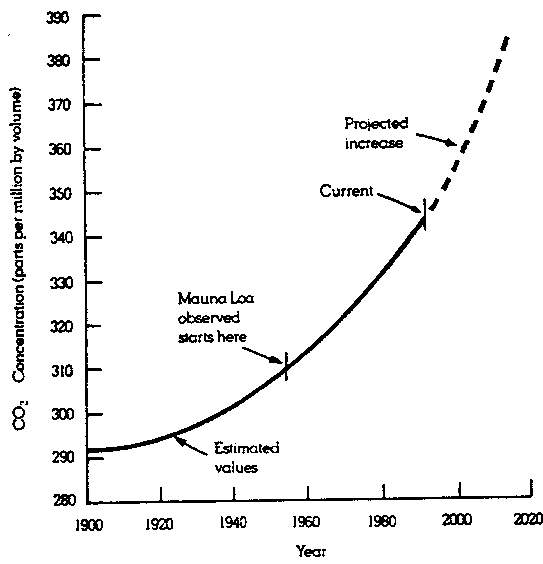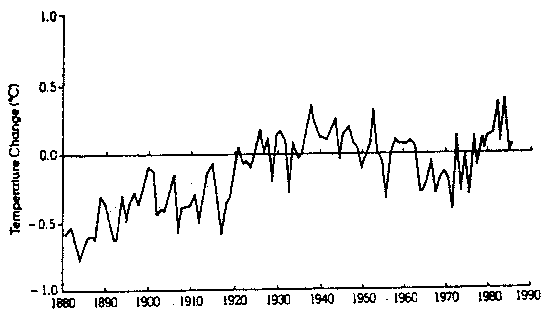Introduction
The greenhouse effect has recently become a major topic of conversation and study in both scientific and political circles. The explanation of how radiation is trapped by the gases in the atmosphere and released only after the temperature of the atmosphere warms sufficiently has become commonplace on talk shows and in science lectures. An increasing concentration of carbon dioxide has been identified as causing the greenhouse effect to become more pronounced.
How should a Christian respond to environmental issues such as this? Are the alarmist statements coming from some environmental groups predicting worldwide catastrophe legitimate? Has the greenhouse effect really become a problem because of careless deeds by mankind, and should we attempt to reduce the release of carbon dioxide by government regulation?
Carbon Dioxide Change
In 1958, observations of carbon dioxide concentration in the atmosphere were begun at an Observatory on Mauna Loa, Hawaii. This site was selected to be representative of the global average conditions near the surface of the earth. Figure 1 shows the change of carbon dioxide concentration since 1958, from Ahrens,1 and the estimated values before observations began and into the next century. The general trend shows an overall accelerating increase in concentration. If no other global variable changes, the concentration is expected to double from the current 350 parts per million within a century.

Figure 1. Observed and Projected Concentration of Carbon Dioxide at Mauna Loa, Hawaii
Global Temperature Change
Throughout much of the earth's history, the global climate was probably between eight and ten degrees centigrade warmer than it is today. This is true whether the geologic ages were long or short. From a creationist perspective, the ice ages occurred following the Flood, but may not have been necessarily associated with extremely cold average global temperatures. Oard2 has presented a model which shows that the ice sheets may have been a result of warm oceans and cold continents, following the Flood.
As recently as 1000 years ago, the Northern Hemisphere was relatively warm and dry. During this time, vineyards flourished, and wine was produced in England, indicating warm, dry summers, and the absence of cold springs. It was during this tranquil period of several hundred years that the Vikings colonized Iceland and Greenland. In the 13th and 14th centuries, Europe experienced extreme weather variations, which caused cold winters, hot summers, great floods, and great droughts.
In the 15th century the climate moderated, but in the 16th century the average temperature began to cool for the next 300 years, resulting in what has been called the "Little Ice Age." During this time, alpine glaciers increased in size and advanced down river canyons. Winters were long and severe; summers short and wet. The vineyards in England vanished, and farming became impossible in the more northerly latitudes. Cut off from the rest of the world by an advancing ice pack, the Viking colony in Greenland perished.
Figure 2 shows the average annual temperature of the surface air over the Northern Hemisphere from 1880 to 1985, updated from Bergman3. In the late 1800s, the average temperature in the Northern Hemisphere began to rise. From about 1900 until 1940, the average temperature of the lower atmosphere rose about 0.3 degrees centigrade, followed by a slight cooling trend, until 1970. During the 1970s and into the 1980s, the average yearly temperature again showed an overall warming trend. The five-year period of 1980 through 1984 was the warmest on record, although the period from 1984 to 1990 has been cooler. The average temperature has warmed by about one degree centigrade, from the low, in 1884, to its extreme high, in 1984.

Figure 2. Average Annual Surface Air Temperature over the Northern Hemisphere
Model Predictions and Limitations
Computer models of the atmosphere, called General Circulation Models (GCMs), have been developed at the National Center for Atmospheric Research and other research centers, to simulate the climate and weather patterns of the earth. These models require tremendous amounts of computer memory and time, to simulate even crudely what occurs in our atmosphere.
Computer modelers are now attempting to introduce changes in the basic parameters, such as the carbon dioxide concentration, and are observing the differences which result Some of the initial findings indicate that a doubling in carbon dioxide concentration will result in approximately five degrees centigrade global warming, which, in turn, produces major changes in circulation patterns and precipitation. Sea level is expected to rise by as much as 300 feet, due to the melting of the polar caps.
Before too much reliance can be placed on these model predictions, however, more attention needs to be placed on the accuracy and precision of the models. Several major problems must be solved: First, a change of one degree centigrade is near the precision of temperature measurements. Although average global temperatures are sometimes quoted to hundredths of a degree, the precision of the dry bulb thermometer, used at almost all weather stations around the world, is 0.5 degree centigrade. Second, the precision of the model in terms of grid size and boundary conditions is limited because of computer constraints. And, finally, several physical processes have been ignored because they are considered of secondary importance, or they are not capable of accurate treatment at this time.
An example of a process which has not been adequately included is cloudiness. Cloud cover is an extremely important process in the atmosphere because it so strongly determines the degree of transmission and reflection of solar radiation. Although considered to be one of the most critical unsolved problems in atmospheric science, it is not treated well, because its parameterization is so inaccurate. Yet, if it were to be seriously considered, the estimates of global warming would most likely be reduced because of the feedback process between warming and cloud cover. The more the warming, the more the cloud cover; the more the cloud cover, the less the solar transmission, and, probably, the less the warming. The real atmosphere is a very stable system, and probably will not produce the major changes predicted by the GCMs, which do not include these cloud cover effects.
Conclusions
It is not yet clear whether the increase in carbon dioxide in the atmosphere is necessarily connected to the observed temperature changes or will result in the dire predictions of further temperature increase and changes in precipitation patterns. Because of this uncertainty, it is probably too early to begin developing public policy on carbon dioxide emissions related to temperature increases. However, because of evidence that other pollutants produce harmful effects, and the potential that carbon dioxide may also be a problem, it may be time that we reconsider our personal role as stewards of this earth. We should not adopt the secular view that "Mother Earth" must be protected at all costs. This is to fall into the error of pantheism, which teaches that the earth, the sun, and the stars are all there is. Such a view is wrong, because it attributes deity to the earth. We need to understand the mandate to "have dominion... over all the earth" that God has given us in Genesis 1:26. Man is responsible to use the earth to sustain himself, and to occupy until the owner returns, as described in Matthew 25:14-30. God expects us to use the earth, and to keep it in good repair, much as a landowner would expect his tenants to keep up his farm while he was away.
Such a balanced view of responsible use will necessitate considered adjustments in personal life styles. As Christians, we are already called to live a simple life committed to the good of others. An extravagant life, wasteful of resources and heedless of others, is inconsistent with the Biblical model of a Christian. Each Christian must listen to the leading of the Holy Spirit in this issue, and adopt a lifestyle consistent with that leading. If, after further study we find a clear link between carbon dioxide emission and global warming, we may need to carefully consider public policy in this area.
References
1. Donald C. Ahrens, 1988: Meteorology Today, 3rd Ed., West Publishing Company, San Francisco, 582 pp.
2. Michael J. Oard, 1986: An Ice Age Within the Biblical Time Frame, Proceedings of the First International Conference on Creationism, Vol.II, Technical Symposium Sessions and Additional Topics, Pittsburgh, Pennsylvania, pp.157-166.
3. K. H. Bergman, 1983: International Journal of Environmental Studies, Vol.20, p.93.
* Dr. Vardiman is Chairman of the ICR Physics Department.













